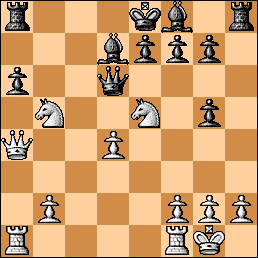I needed to win to qualify for the 2006 US Championship. For a while, everything was going well!
IM M. Ginsburg – IM A. Simutowe US Open 2005, Phoenix, AZ
English 1. c4 c5 2. Nf3 Nf6 3. Nc3 d5 (Grünfeld-like)
1. c4 c5 2. Nf3 Nf6 3. Nc3 d5 4. cxd5 Nxd5 5. e3!? 5. g3 is much more common but the text has its points.
5…Nc6 6. Bb5!? This move is actually quite dangerous.

6…Ndb4?
A very weak move. 6…Nxc3 7. bxc3 Bd7 is acceptable with a small white edge after 8. O-O e6 9. d4 Bd6 10. Rb1 cxd4 11. cxd4 Rc8. SM Patrick Hummel managed a draw in this line versus me, Las Vegas 2002(?) – I will try to find that game score.
7. d4 Of course. The black knight on b4 is just dangling now.
7…cxd4 8. exd4 a6 9. Ba4 b5 10. Bb3 Bf5 11. O-O Na5?! Highly dubious – nothing is out on the kingside in a flagrant violation of opening principles.
12. Bg5! An extremely strong move! A move like 12…f6, while obviously disgusting, is one of black’s only moves now to avoid a quick loss.

12… h6? Falling into the trap. 12… Nxb3? 13. Qxb3 is also really bad.
13. Ne5! The point! The black e-pawn is pinned so the sudden hit on f7 induces grave concessions. In fact, as black stated after the game, he was lucky that he didn’t have to resign straightaway (he overlooked 13. Ne5).
13… Nxb3 14. Qxb3 Be6 Forced.
15. Qxb4 hxg5 And now white needs to take a think and figure out the way to win. It stands to reason there should be something really good here.

16. Rfe1?
Wrong! White had the much stronger 16. a4! as GM Christiansen pointed out to me later. Black is way behind in development and his structure collapses. The variations can be quite beautiful: 16. a4 Qd6 (16… bxa4 17. Qxa4+ Bd7 18. Qc4 e6 19. Rxa6 Rxa6 20. Qxa6 f6 21. Nxd7 Qxd7 22. Nb5 Kf7 23. Rc1 Kg6 24. h3 and wins) 17. Qa5! bxa4 (17… Bc4 18. Nxb5 Bxb5 19. axb5 f6 20. Ng4 Qxd4 21. h3 f5 22. Rfd1 Qe4 23. Re1 Qd5 24.Ne3 Qe5 25. Qa4 Rh4 26. b4 wins) 18. Qxa4+ Bd7 19. Nb5!! and this is not the last fantastic move in this variation! Let’s pause here to look at the situation:

Position after 19. Nb5!! (Analysis) This is the kind of position that GM Christiansen would really enjoy. Continuing, 19…Qb8 20. Qc4 Bxb5 (20…Qxb5 21. Qf7+ Kd8 22. Qf3! Rc8 23. Nf7+ Ke8 24. Nxh8 wins mundanely) 21. Qxf7+ Kd8 22.Qd5+ Ke8 23. Rfc1! Ra7 24. Rxa6!! Fabulous! For the second time in this line, white has landed a heavy, heavy blow.
Let’s look at it:

Position after 24. Rxa6!! (Analysis)
Follow along now: 24. Rxa6!! Rxa6 (24…Bxa6 25. Qf7+ Kd8 26 Nc6+) 25. Qxb5!! Yes! 25…Qxb5 26. Rc8 mate. White gave up almost every piece , is a queen and rook down, and delivers a pure mate! This would have made it into a book of chess miniatures!

Position after 26. Rc8 mate (analysis).
Back to the text. 16. Rfe1? as played is very bad, it gives black time to develop. It doesn’t throw away the edge yet, but the beautiful mating patterns above hopefully illustrate the strength of 16. a4!
16..Bd5 17. Nxd5 Qxd5 18. Qb3?? What the heck is this? Trading queens is a horrific decision. My brain must have been switched off. Note that it gives black an easy way to develop – the classic definition of a soft move according to GM Stohl – and a very weak move!
18. a4! is still strong. For example, 18… e6 19.Qc3 Bd6 20. axb5 Qxb5 21. Qe3 Qxb2 22. Qxg5 O-O 23. Qh4 Qc2 and white is better.)
18… Qxb3 My opponent must have been thanking his lucky stars. 19. axb3 Rh6!
Ugh! I completely missed this move, which gives black a good game! He develops smoothly and I can make no threats! I could sense the game going downhill and I couldn’t believe it – what happened to my initiative??
20. h3 Rd6 21. Nf3 e6 22. Rec1 Be7 23. Rc5? 23. Kf1! is much better. I am shellshocked.
23…Rb6 24. Rc7 Bd8 25. Rc2 Rd6 26. Rc5 Rb8 27. Nxg5 Rxd4
White is flailing around and black improves his position methodically. A tragedy from my standpoint, but a deserved loss, since I made so many blunders after achieving a crushing game. The lesson? Be extra alert and spend extra time looking when it appears like there’s a chance to finish the opponent off quickly!
28. Nf3 Rd6 29. Kf1 Bf6 30. Ne5 Rbd8 31. Re1 Rd5 32. Rxd5 Rxd5 33. f4 Rd4 34. Nf3 Rxf4 35. Ra1 Rb4 36. Rxa6 g6 37. Ra8+ Ke7 38. Ra7+ Kf8 39. Nd2 Bxb2 40. Rc7 Be5 41. Rc8+ Kg7
0-1
It took me quite a while not to be really angry after this game. But it was all my fault! I couldn’t believe I let him get away with his anemic opening play. At least we see a nice mate in a variation! I wound up qualifying for the US Championship at the last possible moment, by defeating GM V. Georgiev in Las Vegas North American Open, December, 2005.














